Whew! Finally, you found the right candidate and they accepted your offer. They start next week.
Your work is done, right?
Think again.
Hiring the right candidate is just the beginning. Without a good onboarding process, you could be wasting all your interviewing efforts.
Table of contents
- 5 Best Practices for Onboarding New Employees
- Common Mistakes in the Onboarding Process That You Need to Avoid
- Make your onboarding process efficient and memorable
Great hires + Poor onboarding = Failed Employees
Are you happy with the onboarding process for your team? Even if you are, your employees probably aren't.
A study by Automatic Data Processing, Inc., found that just 21% of 1,500 employees surveyed were satisfied with their employer's onboarding process.
Another study by Gallup found that only 12% of employees "strongly agree” that their organization does a great job onboarding new employees. Ouch.
It's no secret that successful onboarding reduces turnover. But do you know how much it costs your company to replace your average employee?
The true cost of poor onboarding
According to a study by the Society for Human Resource Management (SHRM), it costs the average company 6-9 months worth of an employee's salary to identify and onboard a replacement.
But that's only the beginning. Companies with successful onboarding programs also report greater revenue and profit margins:

Run the numbers: A mid-level engineer can cost upwards of $200,000 a year. Each additional day it takes for you to get that new team member up and running costs over $800 in wasted salary alone.
A difference of two weeks vs. one month in your onboarding speed would mean potential waste of nearly $8,000 for each new hire. And even if your employees cost a fraction of our example, and you'll still end up with likely thousands in waste.
Worst of all, these numbers are not factoring in the time it took from your other team members to get that new hire up and running, nor the actual productivity the new employee could start delivering.

You can improve your onboarding process
Knowing that onboarding new hires effectively is so important, what should you do if your company's onboarding process isn't very good?
As Andy Grove reminds us, managers can improve the situation for their team regardless of the rest of the company. Today, we show things you can do on your own to ensure a great onboarding experience for the team members you hire, regardless of how the rest of your company does.

5 Best Practices for Onboarding New Employees
There's a lot more to onboarding than learning about a company's policies and where the snacks are. However, figuring out the best process for onboarding your new employees isn't easy.
Here are four tips to help you onboard new employees more effectively:

1. Write out your onboarding plan
The first step to successfully onboarding a new employee starts long before that employee ever walks into your office. It starts when you sit down to craft your onboarding plan.
You may think you know all the steps you want to follow, but until you write it down, you're unlikely to be consistent about it.
If you feel like there are some gaps in your onboarding process, consider using the "Four C's” to help you cover your bases.
The Four C's
The Four C's are a framework created by Tayla Bauer, author of Onboarding New Employees: Maximizing Success.
The purpose of the 4 C's is to help managers get new hires everything they need to get started. Not only so they feel welcomed, but to prepare them for the job so they can start contributing as fast as possible.
The better you take care of your new hires in each of these areas the more comfortable and effective they'll be faster.
The Four C's are:
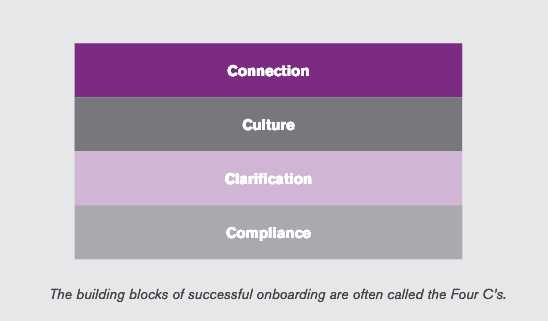
Compliance means getting them the resources they need to know about your policies. Some things everyone is required to do, like working documentation, while there is likely more in this area the bigger your company you work at.
This is information that HR should already be providing. No one ever wanted to read a boring manual, so do your best to either break up these less fun tasks, or do them in a creative way.
Clarification is teaching them about your mission and their role in bringing that mission to life. As we've discussed before, giving people a strong understanding of their purpose and the meaning of their work can really boost morale.
Next, Culture includes your company values and history which has shaped your workplace. If your company has values on the walls, find creative ways to tell the new team member about them. If you can share stories about how your team lived them in the past, all the better.
Finally, Connection is about helping your new hire build relationships and connect with coworkers. Ask yourself: Who do they need to know? Have they met and had a chance to get to know all their fellow team members?
As you can see, there's more to think about than if their computer and logins are ready on day 1. The 4 C's can make sure you do not miss anything important in your onboarding process.

2. Be thoughtful about how you introduce new hires to your culture
How do you introduce new hires to your company's culture? Some companies wing it. Others think that a trip to the local bar at happy hour for a little bonding does the job. Neither of those will get you the best results.
There are countless ways to introduce your new hires to your company's culture. However, the most important thing is just that you're doing it and being thoughtful about how it's done.
The last thing you want is for a new hire to come in and feel alienated right away. To feel as if they just walked into an inside joke that everyone's in on but them.
Instead, help your new hires see and feel what your culture is like. Look for places you can show them the values in action, or stories behind how they were selected.
Your team has a micro-culture, too
Also, consider the habits and behaviors of your own team:
- What are expectations around responsiveness late at night?
- Are there expectations on how and when people comment on pull requests?
- If you have no office administrator to greet visitors, what do people typically do if someone enters?
- What rituals does your team or company have that they should know? (i.e. - casual Friday, WFH Wednesday, no meetings Tuesdays, free lunch days, or company socials)
It's awkward when you feel like an outsider. Doing something the rest of the tribe doesn't can prevent a new team member from feeling truly connected to your team and company.
Giving them a heads up about some of your team's common habits can avoid confusion or unintentional faux pas.
The best way to avoid missing any of these things is to make sure you have a simple checklist of these items. Write it down, and you can always improve it as you hire and onboard more people.

3. Make regular, open communication a priority
Of all 4 C's, connection is the most important.
If you don't help your new employees build the key relationships they need to thrive in their work, you're not giving them what they need to succeed.
A lack of communication can result in confusion and costly problems. And, eventually, them leaving for good.
Deb LaMere, vice president of employee experience at Ceridian says it's important to check in with new team members on a regular basis. And, preferably, in person. LaMere suggests.
"It could simply be a 'How's it going?'...The more you can communicate and share with the new hire in the first few days, the better the experience,"
Better communication doesn't just help new employees feel welcome. It can actually help them maximize their productivity from day 1.
Frequent 1-on-1s are the key to great communication
Product Hunt lead engineer Radoslav Stankov has a thorough onboarding process for the engineers he hires. This includes consistent communication in the form of daily 1-on-1s:
How @rstankov onboards new full-stack engineers to @ProductHunt
— Andreas Klinger 🏝 (@andreasklinger) February 26, 2019
The goal for Week #1:
- Accept offer, build a feature & demo it
Until end of Month #1:
- Remove something from the system
- Create something reusable
Daily 1on1s in first 2 weeks and opt-in for next two weeks.
The result of that consistent communication? So, far, 100% success:
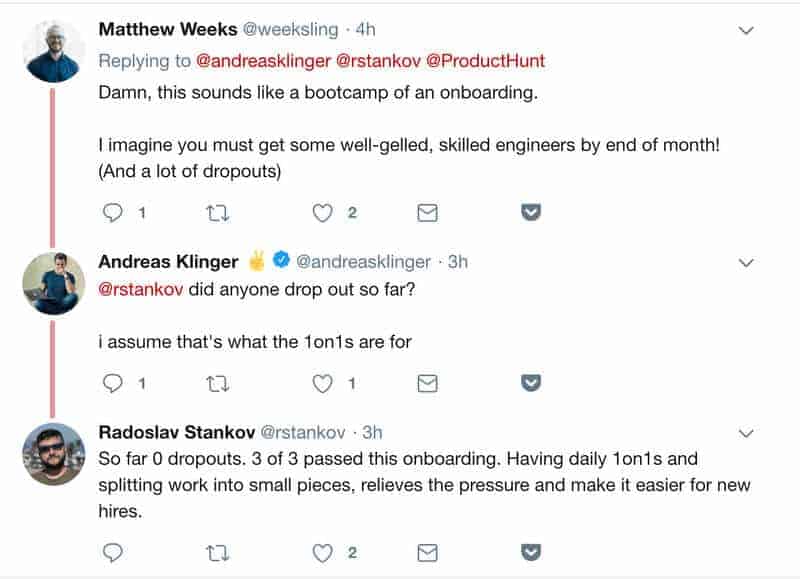
"After week 2/3 we decide if we need a call,” says Stankov, who adds that it's then up to each of them to decide together if they need 1-on-1 time on a particular day.
By keeping that line of communication open, those new team members are free to discuss anything that might be holding them back.
Technology and fancy systems can streamline the learning process. However, nothing can replace 1-on-1 interactions between you and your new hires. No matter how big or small your team or how many resources you have, 1-to-1 communication is essential to onboarding your new employees.
Remember also Andy Grove's lesson on Task Relevant Maturity; being more hands on early on helps you both build confidence and ensure your relationship is built on a strong foundation of regularly communicating.

4. Give each of your new team members a buddy
A buddy system is a simple but effective way to bring your new hires into the company and make them feel welcome. It takes some of the pressure off of you to do everything to onboard them and has a variety of other benefits.
A buddy can do several things for your new team members including:
- Teach them about any unfamiliar tasks or processes
- Show them where to get basic office supplies, where the bathroom is, lunch culture, and how to use equipment
- Explain company guidelines and aspects of your culture
- Share knowledge and wisdom that will help them at your company in general
- And engage them in social activities that create bonding
The buddy system also helps your new hire with asking questions. Instead of worrying about bugging you or another team member, your new employee has a designated buddy they know they can turn to, whether for basic questions and guidance. If you pick someone who was recently hired themselves, they have the added benefit of thinking like the new hire and knowing what questions they're likely to have.
The Percolator
For example, Jason Shen, formerly of content marketing platform Percolate, had a buddy or "Percolator” assigned to him when he started. That Percolator was in charge of helping him get settled into his role and the company as a whole.
Shen described some of the key actions his buddy took:
"On my first day, we went out for lunch at an Italian restaurant nearby with two other new hires (Rachel and McKenna) and their Percolators.
...she stopped by a few times during the week to check on me and helped me with a bunch of random, new-hire questions ("Where can I find pens?”) via chat.”
Shen's buddy not only helped him with basic questions, but also connected him with others in the office so he felt comfortable and connected right away. He knew he had someone it was okay to ask basic questions of, and not feel like he's bothering them.

More than a buddy: a connector, too.
Shen went on to explain that it's also a Percolator's job to take that new hire on a tour around the office and introduce them to their colleagues– all 100 of them.
The office tour fosters bonding in a clever way.
Earlier that week, Shen received an onboarding package with instructions to write an email introducing himself that would be sent to all 100 employees. The email included a bit about his background, where he grew up, and a few random details about himself.
Twenty-five people responded, one even having grown up in his neighborhood of Newton, just outside Boston.
That brings us back to the office tour. When the tour happened later that week and Jason's Percolator was introducing him around, the connections were immediate:
"Because people had read and responded to my introduction email, I could actually have meaningful conversations with a bunch of folks on the team and continue to reinforce my new relationships.”
Shen's buddy helped him smoothly transition into his position. She also helped facilitate valuable friendships that made him immediately feel welcome and part of the company's community.

5. Use small gestures to make new employees feel welcome
In an interview with management blog First Round, HR veteran Carly Guthrie explained that the best managers go out of their way to use small gestures such as hand-written notes and company swag to make new employees feel welcomed on their first day.
"Really great companies don't only provide swag for the new employee (even better, in the right size), but also for their partner and kids if they have them.
Remember, when someone joins your organization, it's not just them that's working there. Especially if they work long hours that can impact their entire family.”
Some startups are taking this a step further and crafting custom welcome kits.
Welcome Kits: Surprise, delight, and everything they need on Day 1
A custom welcome kit is a great way to make your new employees feel welcome. It also introduces them to the culture in a creative, often visual way and prepares them for the position.
Grocery startup Boxed fittingly crafted a custom box with stickers, a t-shirt, and office supplies for new hires:
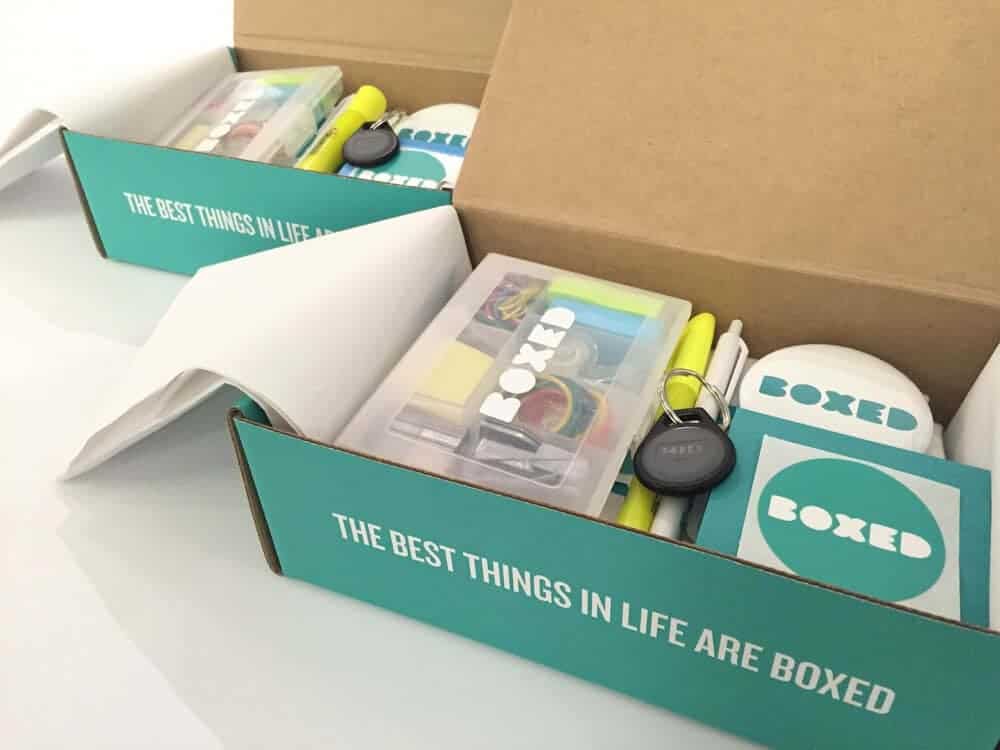
And new UX designers for SalesForce get this kit from the UX team:
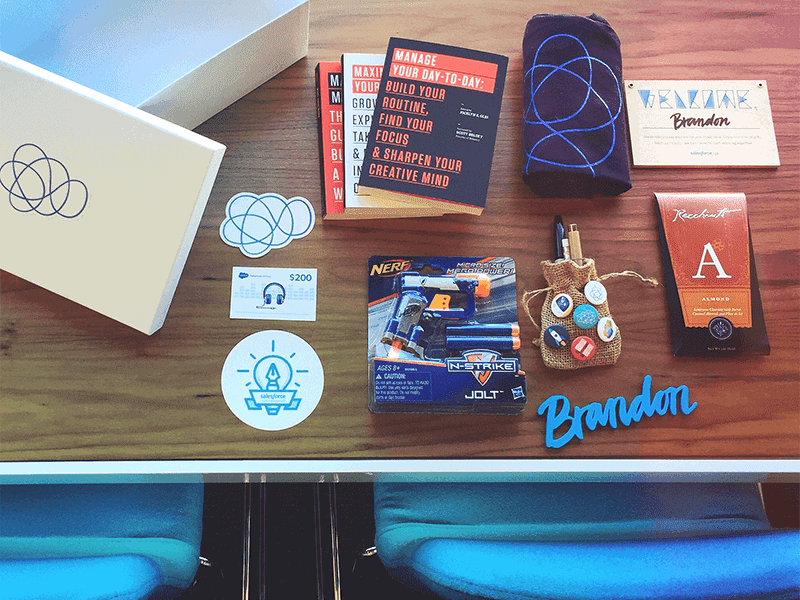
The kit includes pens, stickers, books, a $200 credit for new headphones, a welcome note, and a few items which express the fun side of the SalesForce culture including a mini-Nerf gun.
Meanwhile, Square gives this square-themed package which includes items such as the book The Checklist Manifesto: How To Get Things Right by Atul Gawande, a favorite of CEO Jack Dorsey:

The kit also includes several other square-shaped items such as a Starbucks gift card and a large card titled "The Four Corners of Square” which details the company's central values.
Going a step further, cloud communications platform Twilio has new hires come up with their own unique app idea and create it all in one week. Then, at the end of the week, those new hires present their app at a special company dinner in front of colleagues.
After their whirlwind crash-course, new hires are presented with this welcome package, which includes a Kindle Paperwhite, Twilio track jacket, and a $30 monthly book stipend for further learning:
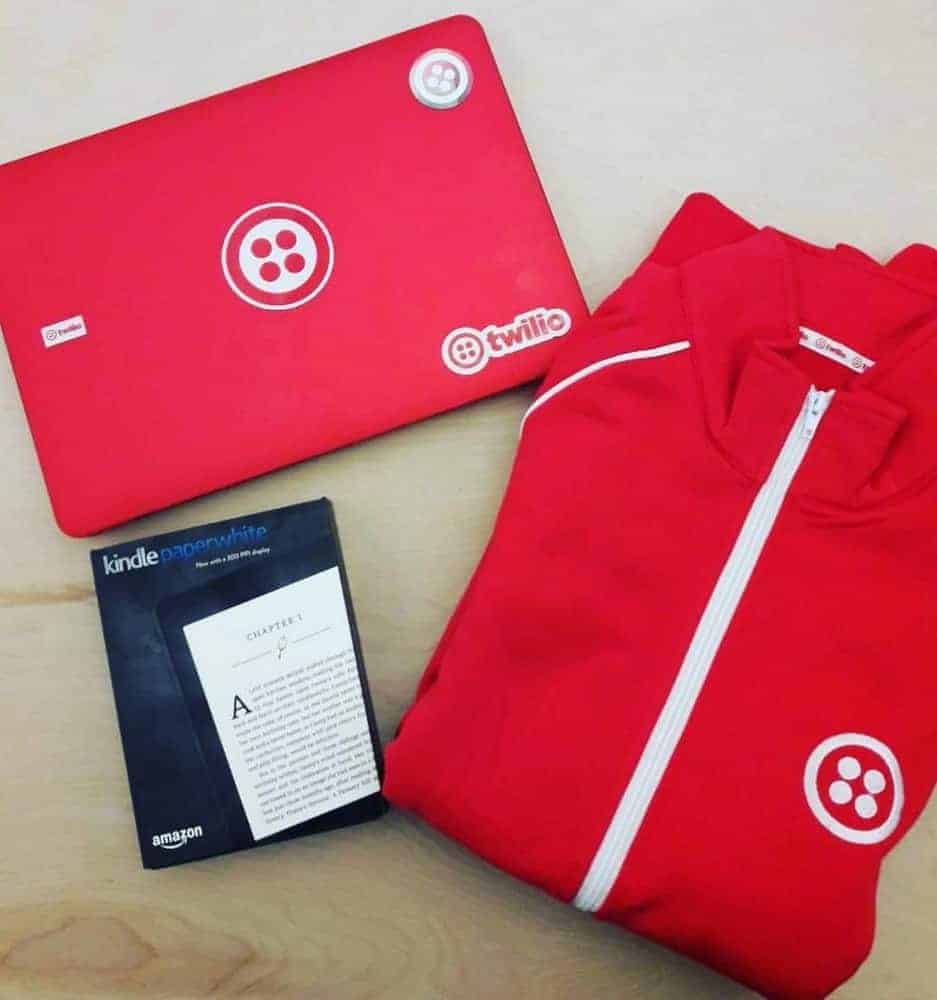
There's no right or wrong way to do a welcome package or any kind of thoughtful gesture such as this. The important thing is that you give your new hire everything they need to get started smoothly, and you'll score major bonus points by adding thoughtful items as well.
It's the thought that counts!
If you can get your company to support major investment in a welcome kit, you'll create a remarkable experience they'll talk about; many of the photos above come from employees excitedly sharing them.
However, if you're limited in budget you can still do some basic things to welcome them:
- Grab a T-Shirt in their size from your company's swag pile.
- Get them a small gift card to cover coffees with colleagues in their first week. This can be $20 very well spent, even if out of pocket.
- Take the team to lunch or out for drinks so the team can all meet them in a relaxed environment.
- Work with them in advance of their start date to order the equipment they need so it's all there and unboxed when they arrive on day 1.
Get creative! In even a few minutes of brainstorming, I bet you and your team could come up with a few fun, inexpensive things to present a new team member with that would welcome them and introduce your culture.
Common Mistakes in the Onboarding Process That You Need to Avoid
We just shared with you 5 best practices to create an awesome onboarding process for your new employees.
However, as important as those approaches are, it’s also important to know the mistakes you should avoid. These can derail an otherwise promising onboarding, which means hurting a great, new hire.
To ensure your good onboarding doesn’t fall off track, avoid these common pitfalls managers fall into:
Mistake №1. Not Giving Enough Context
It's tempting for managers to dive right into assigning tasks and responsibilities to new hires. You likely have a lot that needs to get done. And you want to see returns from your new teammate as fast as possible.
However, this is a key moment to slow down. Unless you deliberately spend time providing the context they need, there's a good chance your new hire will feel lost and struggle to complete the task.
Your knowledge != their knowledge
It’s easy to forget that you know a lot more than your team members; you have access to more information, data, and decisions than many on your team do. This is especially true for new hires.
Without enough context, you set your new hire up to struggle. Be careful giving them their work without explaining the bigger picture; doing so is like throwing them into the ocean without a life jacket, or sending them hiking with a compass or map.
Here are some key areas where managers often fail to provide adequate context:
- Company vision and mission — make sure to clearly explain your company's overall vision, mission and values. Help them understand the "why" behind the business. This will give them the meaning and purpose of their work, which can dramatically affect their performance.
- Team goals — walk through your team's current goals and objectives. Explain how their role plays a part in achieving them and what their priorities are. They need to understand what’s important to focus on, and what can wait or is unimportant.
- Measures of success — be clear about what success looks like in their role. Make sure they understand how they’ll be evaluated and what your expectations are. You never know what the situation was at their last job, so never assume they “just know.”
- 3rd rails and potholes - The last thing you want to hear a new hire say is, “Why didn’t anyone tell me about that!?” It’s well worth you and your team’s time to let your new hires know about any cultural faux pas to avoid, as well as any known problems in your code base, support system, or other tools.
With a little thought and preparation ahead of time, you can avoid people having painful experiences and wasted time.
Remember: as a manager, you’re responsible for the outcomes of your team. Do your part to help get the best possible outcomes by thinking ahead to the helpful context your new employees need whether that’s good, bad, or ugly things. All will help them do their job better and avoid any embarrassing experiences early in their time at your company.
Mistake №2. Trying To Teach Everything At Once
It's exciting when a new teammate joins your team. You finally have extra hands to help lighten everyone’s workload.
At this point, it's very easy and tempting to immediately dump everything on them at once. This can include assigning their first tasks, giving them long training sessions back-to-back, and loading them up with manuals, resources, and data to read.
But this approach can completely overwhelm your new hire. It’s hard to absorb everything all at once, and know what is essential for them to remember vs nice to know.
This “drinking from the firehose approach” can lead to a number of problems:
- Your new hires feeling stressed and anxious from information overload
- Poor retention of covered material leads from not knowing where or how to apply it
- Underperformance of tasks due to an inability to focus and being spread too thin
- Getting up to speed more slowly due to too many meetings and distractions
To avoid this common onboarding mistake, space out your training and onboarding efforts. Break the information you want them to learn down into digestible chunks, and spread them out in order of priority.
You can also really help them by letting them know what is essential and what information is simply “mandatory” HR stuff, or of lower importance.
Mistake №3. Ignoring the Pre-Boarding Process
Thinking that onboarding starts on your employee’s first day is a very common mistake.
A good onboarding process starts during the "pre-boarding" phase. This is after they’ve signed their offer to work at your company, but haven’t walked in the door on their first day. Mistakes made at this point can sabotage an otherwise well thought out onboarding process.
The first part of good “pre-boarding” is to make sure your team member has everything they need like:
- Their work computer, and if applicable work phone: With supply chain challenges and order delays, you can’t guarantee you can get one the day before.
- System logins, work email, and other credentials: Nothing makes someone sit on their hands more on day one than not having access to the tools and systems needed to work at your company.
- Letting all the right people know their start date: Just because you know when someone starts doesn’t mean others on your team or department know. Make sure they know in case there are things they should prepare as well.
- Key paperwork they can start ahead of time: Whatever legal/HR/compliance tasks they need can often be sent over in advance, which means they can complete it at their leisure and focus on hitting the ground running on your team
A little planning ahead can go a long way. By keeping these tasks in mind, and involving the right people at your company, you can make sure that none of these pre-boarding steps are forgotten.
That ensures you make a great first impression, and don’t have people frustrated literally on day 1. You also avoid annoying or frustrating your coworkers who also are involved with your new hire.
Make your onboarding process efficient and memorable
No matter what your company's onboarding process looks like, there's a lot you can do. Not only to make new employees feel welcome, but to integrate them quickly into both your culture and workflows.
It's up to you to decide what that process looks like. But keep these points in mind as you craft (or improve) your own onboarding process:
- Craft a starter onboarding plan; any checklist is a good start so you don't forget anything before they arrive on day 1.
- Focus on integrating them into the company culture and building the vital relationships that new hires will need to thrive from the start. Ask who they need to meet and what could trip them up.
- Make open communication a priority with frequent 1-on-1s checking in with them.
- Give your new hires a buddy they can ask questions of, and who can show them around, so it's not all on you.
- Use small gestures like swag on their desk, or a full-on welcome kit to welcome your new team members and introduce them to the company culture in a memorable way.
With these tips, you can not only improve your onboarding process but also make it more memorable for new employees and efficient for your team as a whole. A little planning and thoughtfulness on your part can improve how quickly your hires get up to speed, and make the best possible first impression with them.
Don't make your onboarding process an afterthought – make it a key part of your team's culture. A few minutes of organizing and thoughtfulness can make the difference between a great first day, and days of lost productivity.

What is considered a good onboarding process?
Good onboarding is the process that welcomes new hires and sets them up to succeed. A solid onboarding plan isn't just the first day — it starts earlier and continues for weeks.
Here’s what good onboarding includes:
- Preparation begins before day one, ensuring the new hire's workspace is ready and your colleagues know about the new team member.
- A clear plan and understanding of how the onboarding should go, so the right things get done at the right time.
- Briefing about the company vision, KPIs, goals, and measures of success.
- Consistent feedback channels like 1-on-1 meetings to help answer questions and support them.
- Spaced training over weeks, not hours, to prevent overload and prioritize the most important information first.
- Big and small gestures, like welcome kits, for new team members.
How long does the onboarding usually take?
There is no single answer to this question. The length of onboarding depends on factors like the complexity of the role, the size of the company, and the norms in your industry.
Effective onboarding takes time. Rushing through it can lead to poor retention and wasted hiring efforts. As covered in this post, a thoughtful onboarding process will provide new hires with what they need across four key areas (the 4 C’s):
- Compliance — getting familiar with policies, paperwork, systems access, etc. . This can take a few days to a couple of weeks to complete, depending on your company.
- Clarification — gaining an understanding of their role, priorities, and success metrics. Managers should put time in the first month for ongoing discussions as questions come up.
- Culture — learning the company values, norms, and unwritten rules that shape the environment. This step takes weeks and months through formal training and daily interactions with your team and customers.
- Connection — building vital relationships and a support network across teams. Good managers ease introductions right away, while connections strengthen over the first 3 months.
In most cases, it takes at least 3 months to complete all this and have a fully productive, onboarded employee.
What are the steps in the onboarding process?
While each company handles onboarding a bit differently, most effective onboarding processes have the following key steps:
- Pre-boarding preparation (paperwork, equipment, notifications)
- Day one orientation (introductions, overview / tour, HR briefing)
- Ongoing training (core systems for their work, company knowledge, first assignments)
- Relationship building (meetings with key colleagues, attending team events, working with a mentor or peer)
- Evaluation period (30/60/90 day milestones, gathering feedback on first projects)
- Role mastery (reduced supervision, increased ownership)
The early parts focus mainly on company compliance, clarifying responsibilities, and establishing lines of communication. Then, over time they start to build confidence and competence, before ultimately being a fully onboarded, regular contributor to your team.




